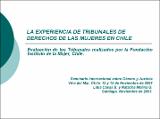|
Reseña:
|
The Women’s Rights Tribunals held throughout Latin America and the Caribbean during the 1990’shave provided activists with a great deal of experience in this area. The majority of the Tribunals,which were based on the World Conferences in Vienna (1993) and Huariou, China (1995), combinepublic claims objectives with exchanges between women or regional debates and offer a publicplatform for denouncing discrimination and developing solutions.Women’s Rights Tribunals are symbolic events that have an eminently judicial format in that theysimulate oral, public and adversarial proceedings, in which all of the elements of the case arepresented in order to hold a real accusatory trial. The Tribunals feature witnesses’ testimony and lookto make the discrimination that women face in various areas of public and private life visible to thegeneral public. They also look to sensitize and challenge the judges and authorities who are chargedwith making decisions to do so in keeping with international law, and to impact legislative and publicpolicies in order to promote respect for women’s rights in the matters brought before the court.The topics that are most frequently addressed during Women’s Rights Tribunals are related todiscrimination in the field of sexual, reproductive and family rights (rape, domestic violence,stigmatization of teen pregnancy and motherhood, abortion, sexual harassment in the workplace andfamily planning). The Tribunals tend to pay less attention to the areas in which one finds the highestlevels of legal, cultural and social resistance, such as labor laws, political participation and racial orethnic discrimination.The organizations responsible for holding the Tribunals select issues culled from the public agendathat are of interest to citizens and the media, which gives them a real chance to be included in policyagendas.Women’s Rights Tribunals look to sensitize judges and authorities and to change the ways in whichthey make their decisions by questioning traditional forms of judicial application and pointing outblind spots. The results are not immediate, but have their impact in the area of deeply rooted socialand institutional preconceptions. They can, however, impact proposed legal reforms and publicpolicies by raising issues such as changes to the criminal procedure code in the area of sex crimes, asexemplified by the case of Juana Candia.One of the achievements of this movement was the Third Chilean Women’s Rights Tribunal, whichfeatured the case of Marcela Valdes and allowed the organizations involved to create or deepenrelationships with social actors who promote legal actions that are designed to create public interest.Though the explicit purpose of the tribunals is not to affect these types of changes, experience showsthat they can lead to changes or to a questioning of the individuals involved with discriminatory acts,as seen in the cases of Juana Candia, Juana Manzano and Marcela Valdes.The authors also suggest ideas for improving the impact of Women’s Rights Tribunals, includingstrengthening and deepening judicial analysis by making the sentences more substantial and ensuringthat they have a greater impact in the legal community. They also suggest an increase in theopportunities that are provided for questioning the decisions and behavior of the judicial authoritiesinvolved and limiting partisan interpretations of the results.Finally, the authors conclude that the Tribunals that were implemented in Chile represent examplesof an exercise that is both a political tool, in that it promotes visibilization and sensitization andeducates the legal community in regard to the relationship between gender and justice. They also notethat the Tribunals can serve a methodological instrument that can be used as a strategy forintervening in the area of judicial administration. |

